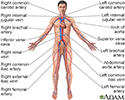Raynaud phenomenon
Raynaud disease; Primary Raynaud; Secondary Raynaud
Raynaud phenomenon is a condition in which cold temperatures or strong emotions cause blood vessel spasms. This blocks blood flow to the affected regions and causes discoloration
Causes
When Raynaud phenomenon is a primary condition, meaning it occurs by itself and not in association with other diseases, it is referred to as Raynaud disease. It most often begins in women younger than age 30. Secondary Raynaud phenomenon is when the condition is linked to other conditions and can occur at any age.
Common causes of secondary Raynaud phenomenon are:
- Diseases of the arteries (such as atherosclerosis and Buerger disease)
- Drugs that cause narrowing of arteries (such as amphetamines, certain types of beta-blockers, some cancer drugs, certain drugs used for migraine headaches)
- Arthritis and autoimmune conditions (such as scleroderma, Sjögren syndrome, rheumatoid arthritis, and systemic lupus erythematosus)
- Certain blood disorders, such as cold agglutinin disease or cryoglobulinemia
- Repeated injury or usage such as from heavy use of hand tools or vibrating machines
- Smoking
- Frostbite
- Thoracic outlet syndrome
Symptoms
Exposure to the cold or strong emotions bring on the changes.
- First, the affected areas become white, and then turn blue. Fingers are most commonly involved, but toes, ears, lips or the nose can also change color as well.
- When blood flow returns, the area becomes red and then later returns to normal color.
- The attacks may last from minutes to hours.
People with Raynaud disease have problems in the same fingers on both sides. Most people do not have much pain. The skin of the arms or legs may develop bluish blotches which goes away when the skin is warmed up.
People with secondary Raynaud phenomenon are more likely to have pain or tingling in the fingers. Painful ulcers may form on the affected fingers if the attacks are severe.
Exams and Tests
Your health care provider can often discover the condition causing Raynaud phenomenon by asking you questions and doing a physical exam.
Tests that may be done to confirm the diagnosis include:
- Examination of the blood vessels in the fingertips using a special lens called nailfold capillary microscopy
- Vascular ultrasound
- Blood tests to look for arthritic and autoimmune conditions that may cause Raynaud phenomenon
Treatment
Taking these steps may help control Raynaud phenomenon:
- Keep the body warm. Avoid exposure to cold in any form. Wear mittens or gloves outdoors and when handling ice or frozen food. Avoid getting chilled, which may happen after any active recreational sport.
- Stop smoking. Smoking causes blood vessels to narrow even more.
- Avoid caffeine.
- Avoid taking medicines that cause blood vessels to tighten or spasm.
- Wear comfortable, roomy shoes and wool socks. When outside, always wear shoes.
Your provider may prescribe medicines to dilate the walls of the blood vessels. These include topical nitroglycerin cream that you rub on your skin, calcium channel blockers, sildenafil (Revatio), and tadalafil (Adcirca).
Low dose aspirin is often used to prevent blood clots.
For severe disease (such as when gangrene begins in fingers or toes), intravenous medicines may be used. Surgery may also be done to cut nerves that cause spasm in the blood vessels. People are most often hospitalized when the condition is this serious.
It is vital to treat the condition causing Raynaud phenomenon.
Outlook (Prognosis)
The outcome varies. It depends on the cause of the problem and how bad it is.
Possible Complications
Complications may include:
- Gangrene or skin ulcers may occur if an artery becomes completely blocked. This problem is more likely in people who also have arthritis or autoimmune conditions.
- Fingers may become thin and tapered with smooth shiny skin and nails that grow slowly. This is due to the poor blood flow to the areas.
When to Contact a Medical Professional
Contact your provider if:
- You have a history of Raynaud phenomenon and the affected body part (hand, foot, or other part) becomes infected or develops a sore.
- Your fingers change color, especially white or blue, when they are cold and don't return to their usual color.
- Your fingers or toes turn black or the skin breaks down.
- You have a sore on the skin of your feet or hands which does not heal.
- You have a fever, swollen or painful joints, or skin rashes.
References
Cameron J. Vascular surgery. In: Cameron J, ed. Current Surgical Therapy. 14th ed. Philadelphia, PA: Elsevier; 2023:chap 16.
Landry GJ, Repella TL. Raynaud phenomenon. In: Sidawy AN, Perler BA, eds. Rutherford's Vascular Surgery and Endovascular Therapy. 10th ed. Philadelphia, PA: Elsevier; 2023:chap 142.
Roustit M, Giai J, Gaget O, et al. On-demand Sildenafil as a treatment for Raynaud phenomenon: a series of n-of-1 trials. Ann Intern Med. 2018;169(10):694-703. PMID: 30383134 pubmed.ncbi.nlm.nih.gov/30383134/.
Stringer T, Femia AN. Raynaud's phenomenon: current concepts. Clin Dermatol. 2018;36(4):498-507. PMID: 30047433 pubmed.ncbi.nlm.nih.gov/30047433/.
Raynaud's phenomenon - illustration
Raynaud's phenomenon
illustration
Systemic lupus erythematosus - illustration
Systemic lupus erythematosus
illustration
Circulatory system - illustration
Circulatory system
illustration
Review Date: 4/30/2023
Reviewed By: Neil J. Gonter, MD, Assistant Professor of Medicine, Columbia University, New York, NY, and private practice specializing in Rheumatology at Rheumatology Associates of North Jersey, Teaneck, NJ. Review provided by VeriMed Healthcare Network. Also reviewed by David C. Dugdale, MD, Medical Director, Brenda Conaway, Editorial Director, and the A.D.A.M. Editorial team.















